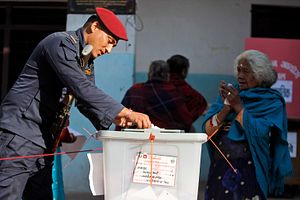From May through December 2017, Nepal held elections in five separate stages for all three levels of government: local, provincial, and national. Voter turnout was high – roughly three-quarters of eligible voters voted in the local elections, and about two-thirds voted in the provincial and national polls. Despite rapid urbanization, most voters must cast their ballots in their place of birth, so millions traveled long distances over rough terrain to their home villages, braving muddy roads during the early stages held during monsoon season, and freezing temperatures during the later stages held in winter.
Because the elections were held over several months, political alliances shifted between the initial local and final national and provincial elections, generating some surprises. Most significantly, a new Left Alliance emerged in October, comprised of Nepal’s two largest communist parties, the Communist Party of Nepal (Maoist Center) and the Communist Party of Nepal (Unified Marxist-Leninist) (CPN-UML). Though the Maoists and CPN-UML had been bitter rivals, they announced plans to run together for the provincial and national polls and merge into a single, unified party following the elections. Unity would enable them to win a majority, their leaders claimed, and to bring “prosperity through stability” – the latter being somewhat of a novelty in Kathmandu, where unstable coalition governments have been the norm since multi-party democracy was established in 1990.
In the end, the Left Alliance came out ahead in the elections at all three levels of government. In the national parliament, the Left Alliance holds a majority, though just under the two-thirds majority needed to make any changes to the country’s fledgling constitution, which was promulgated in 2015. Their main rival, the center-right Nepali Congress, was trounced, securing less than a quarter of seats in parliament.
Whether the Left Alliance will make good on its election promises remains to be seen; they have yet to form a government. Before the coalition can do so, elections for the National Assembly – the upper house of parliament, which is selected by provincial- and local-level officials – must be held. Despite initial disagreements over how to conduct these elections, they have been scheduled for February 8. If ongoing protests over the naming of provincial capitals do not throw a wrench in the works, the new government could be formed as early as mid-February.

































